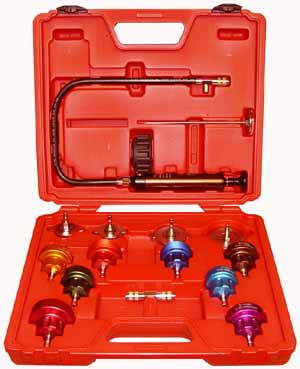A video by Eric the car guy
Cooling systems are vital to any car running correctly, and are often time mis-diagnosed. This is because a lot of technicians today over think it, and often times forget to check the little things. This article is aimed at the backyard mechanic or everyday do it yourselfer. It will help you to understand how to properly pressure test your vehicles cooling system. This is one of the simplest, yet most effective tests for diagnosing a cooling system.
In order to understand how to properly pressure test your cooling system, we must first discuss how a cooling system works. A basic cooling system is fairly simple. It uses a radiator placed in the front of the vehicle. This is what transfers the heat from the coolant thus cooling the coolant and cooling the engine. There is a pressure cap located on the radiator. This pressure cap serves as not only a safety device for when your coolant system becomes overheated thus relieving pressure; however, the cap also provides pressure to your cooling system, this pressure helps to increase the boiling point of the coolant. This allows your engine to run at the correct operating temperature without boiling the coolant. The next object in your cooling system is the thermostat. This opens and closes, and the main job of this is to bring the engine up to proper operating temperature as quick as possible and maintain the correct operating temperature. For further diagnosis on thermostats you can consult this article How to replace your thermostat. The last item in your cooling system is the water pump. This pumps water/coolant throughout your engine. These items along with the hoses and water passages in your block make up your engines cooling system.
Now that we understand how your cooling system works, we can discuss how to properly pressure test your cooling system. The pressure test will show if your cooling system is leaking in any place. It also lets you know if your cap is working correctly.
THE PROCEDURE
- Park your vehicle.
- Allow the engine to cool down completely. This is extremely important. IF YOU DON’T LET THE ENGINE COOL DOWN YOU RISK HAVING BOILING COOLANT SPRAY ALL OVER YOU CAUSING SEVERE BURNS.
- With the engine completely cool, take a rag and place it over the cap. This is just a precautionary measure.
- Using the rag, turn your body away and gently twist the cap until it catches at the first catch, this will allow any boiling coolant to escape.
- After you have relieved any excess pressure, you can fully remove the radiator cap.
- You will need to get a cooling system pressure tester. If you don’t have one, this Pressure Tester list should help.
- Once you have your cooling system pressure tester, take and find the correct size fitting that fits onto the radiator fill end. Then screw this fitting in place. Make sure that it is all the way down to prevent any unwanted leaks.
- With the cap in place connect the vacuum pump and gauge from the kit. If you are unsure how to connect this, follow the instructions in the manual on how to properly connect the vacuum pump and gauge.
- After you connected your gauge, you will want to look on top of your radiator cap. You are looking for a pressure value. This is the pressure rating for your cap. Remember this number.
- With the number that you located from your cap, use the highest pressure value and pump the vacuum pump up to that value. This will pressurize the cooling system to the max psi that it could see with that cap.
- Watch the needle on the pressure gauge; if it goes down or drops rapidly, you have a leak somewhere.
- To help find the leak enlist the help of friend. Have them pump the pump and continue pumping it while you listen for any leaking air.
- If you ca’t hear any air escaping you can try using soapy water and a spray bottle and follow the hoses and see if you can see any spots where it is bubbling while spraying, this would show that you have a leak.
- If your gauge stays consistent, then you don’t have a leak. If you had a vehicle that was having an overheating problem then you can try running it with the pressure tester connected. This would simulate a working cap. If your vehicle does not overheat then you have pressure cap that is causing the coolant to boil before it should because the system is not pressurized.
I hope this article helps to show you how to properly diagnose what is wrong with your cooling system on your vehicle.
Tags: antifreeze, ast, coolant, Cooling System, pressure, pressure test, pressure test cooling system, pressure tester, radiator, radiator cap, thermostat, Tools

